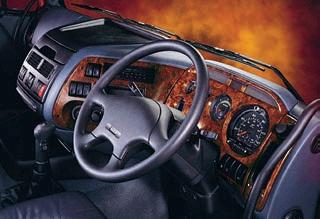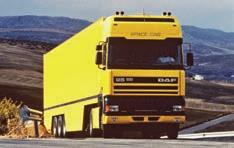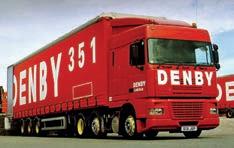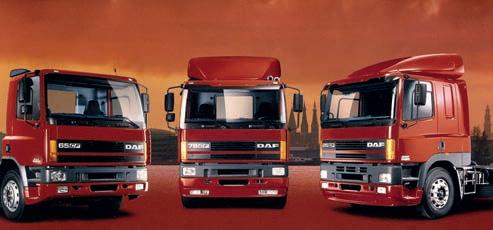
14 minute read
DAF IN THE UK What is it that sets Britain’s top truck brand apart? Right from the start, success has been about customer relationships
WORDS: SIMON PETERS / PHOTOS: DAF
Back in the day, the question that mattered to most people was ‘Who’s top of the pops?’ Nowadays it’s ‘How many followers have you got?’
Advertisement
Numbers matter, because they imply so much about you. So being the top-selling brand in an industry as demanding and exacting as trucks is nothing short of remarkable. But being market leader for 25 consecutive years? That’s incredible...
Transport operators are level-headed, logical and pragmatic, after all. To them, trucks are a tool to do a job, assets to support what they do, resources to help them make money. Nobody puts their con dence in any one supplier lightly, and certainly not for that long.
For DAF to be market leader –to be selected as the industry’s top business partner, continuously, in what is above all a service industry – speaks volumes about the brand, the products, the people and the whole approach to business. Accolades like this have to be earned.
Market leadership isn’t the down payment for a promise – it comes from disciplined, dedicated hard work and effort over a long period of time. DAF has had to go on proving itself to win, and more importantly retain, that leadership over the years.
DAF FACT FILE EARLY DAYS Let’s go back to the times when home brands dominated the British truck market. Leyland topped the list until the 1970s creation of a politically convenient, catch-all BL Group.
TOGETHER STRONGER

DAF : 25 YEARS OF TRUST AND GOODWILL
Destabilised by government interference and poor management, the leading truck manufacturer in the world, saw resources bleed away from its core business to support an ailing car industry.
As a result, the once-proud Leyland Trucks was starved of cash, leaving it dependent on government subsidies and looking for partners just as the doors of European opportunity were truly beginning to open. A 1980s change of political direction wanted simply to of oad the problem – an unfair re ection of a still-great brand that had so much to offer.
Contrast that with a 1970s DAF. From humble beginnings, DAF had grown steadily to become a mid-stream
UK operators have played a major part in the continued DAF success story – and it is a relationship to be proud of
heavy trucks player across Europe. Step by step, markets had opened up to the brand, gaining it recognition and respect, especially in its approach to customer service. Established in 1973, its ‘International Truck Service’ led the way in supporting operators roadside, and that dependability had already won the brand many friends.
DAF came to the UK soon after Volvo and Scania. Doing the right things rst, it prioritised building a support network based on enthusiastic support network based on enthusiastic and committed dealers right across the and committed dealers right across the country and worked hard to build a solid country and worked hard to build a solid business base on which to expand. business base on which to expand.
DAF had always been close to Leyland – the Leyland engines created Leyland – the Leyland engines created the blueprint for DAF’s in-house engine the blueprint for DAF’s in-house engine range. So it was a hardly a surprise when range. So it was a hardly a surprise when the two brands moved closer together in the two brands moved closer together in the mid-1980s with Leyland supplying the mid-1980s with Leyland supplying a Roadrunner-based lightweight truck a Roadrunner-based lightweight truck range for DAF. range for DAF.
Talks on closer ties began in 1986 and in spring 1987 the deal was sealed. A new DAF emerged blinking into the sunlight – one company, rather that the two-brand approach adopted by others.
Of course, it was in the UK that the move had most impact. On mainland Europe little changed. In the UK, a completely new brand, Leyland DAF, was born. It was a name that created huge interest, along with considerable speculation. Would DAF threaten the heritage and deep-rooted respect so many still had for Leyland? Would Leyland swamp DAF’s fast-reacting, customer-responsive way of doing business? Could Leyland’s British roots give its new Dutch partner added ‘Buy British’ eet credibility?
Goodwill prevailed. It was as if the market really wanted this merger to succeed, with its 24% market share of day one shooting to 27.5% within four years.







TOUGH TIMES But these were tough times. Recession had hit the UK and Europe, and by 1991 demand for trucks in the UK had fallen over 50% compared with two years earlier. Merging two companies and investing in new products pushed up costs for DAF. Freight Rover had been part of the deal and the cost of developing a new van, almost from scratch and despite having a partner in Renault, was huge. At the same time, the end of the Cold War in Europe meant lucrative military contracts were being wound back. Developing an entirely new 18- to 44-tonne truck range (today’s CF) 18- to 44-tonne truck range (today’s CF) just heightened the challenge. just heightened the challenge.
Falling markets and rising costs don’t Falling markets and rising costs don’t


Leading the way: DAF’s reputation for thoughtful innovation, and British build quality, has helped sustain its reputation through the ages





go together, and on 3 February, 1993 DAF called in the receivers. Operating under such a cloud was a potential marketing disaster, but the UK’s affection for the brand helped turn things around. Goodwill prevailed, and it came from all sides. Operators kept buying; dealers kept working; and the wheels of Leylands, DAFs and Leyland DAFs just Leylands, DAFs and Leyland DAFs just kept turning. kept turning.
Belief became the central tenet of Belief became the central tenet of


NEED TO KNOW
Paccar purchased DAF in 1996 and then in 1998 went on to acquire the Leyland Assembly Plant
DAF FACT FILE
the DAF proposition. There was an acceptance that the support would acceptance that the support would keep coming, that dealers would keep keep coming, that dealers would keep working and parts would keep being working and parts would keep being supplied and that DAFaid technicians supplied and that DAFaid technicians would keep turning up to breakdowns, would keep turning up to breakdowns, as always within the hour. The market as always within the hour. The market believed that DAF would nd a way believed that DAF would nd a way through its dif culties and come back through its dif culties and come back even stronger. It wanted to believe. And even stronger. It wanted to believe. And

come back even stronger, it did.
Here in the UK, under the skilful management of David Gill and his team, outwardly almost nothing changed. With a ‘backs to the wall’ approach, the Leyland DAF family came together to focus on one thing alone – looking after customers. And the market was delighted, rewarding the brand with a return to market leadership in 1995, just two years later.
NEW BEGINNING Hard work, determination and dedication brought the company through. But security was needed if DAF was really to thrive in the longer term. That arrived with Paccar’s 1996 purchase of DAF and 1998 acquisition of the Leyland Assembly Plant.
Paccar gave DAF – and Leyland DAF here in the UK – the chance to



spread its wings and make the most of its undoubted strengths. To its eternal credit, Paccar didn’t come in and try to change everything – instead, it harnessed the goodwill vested in the brand by employees, dealers, operators and everyone involved. It gave the company its head in developing products and technologies to meet the rapidly evolving needs of the European transport sector. And it encouraged the company’s response to new emissions requirements, focusing in particular on improving ef ciencies and reducing costs of operation.
Every bit as important, it instilled in DAF new disciplines. Against a background of strong nancial management and an enthusiastic, yet conservative approach to innovation, Paccar pursued its philosophy of consistently investing in better ways of doing things. The spirit extended to new products. DAF launched upgrades to all of its product ranges in each of Paccar’s rst four years of ownership, and the market responded by continuing to reward DAF with its support.
But it was in the early 2000s that DAF really put the seal on its position here in the UK. Euro-3 emissions legislation was introduced in 2001 and DAF was there, ready to respond with new XF and CF heavy truck ranges.
From 19% market share in 2001, DAF leapt to 24% share in 2002, 28% share by 2005 and a whisker under 30% share by 2009. The 2001 launch of the new LF lighter-weight range was indicative of the company’s innovation and rapidly established a new market standard for lighter-weight trucks.
Of course, in any market, a brand’s sales performance is dependent on the activities of its competitors, and the UK truck sector is an incredibly competitive environment. It is a fact that everyone makes a good truck these days, yet throughout DAF has continued to lead the sector with an authority that’s almost natural.
NEED TO KNOW DAF gradually built its market share to more t 30% in 2016, with a futher rise to 30.5% in 2019
DAF FACT FILE THE DAF DIFFERENCE So what are the factors that have sustained its market dominance so convincingly over the last 25 years? What is it that delivers ‘the DAF Difference’?
Top of the list comes the dealer network. To operators large and small, DAF dealers are the embodiment of DAF – they deliver the reality of the
MODEL OVERVIEW AND AXLE CONFIGURATION
LF City
LF 150 LF 170
LF 8-12t
LF 14-16t
LF 19t
CF PX-7
CF MX-11
CF MX-13
LF 180 LF 210 LF 230 LF 260
LF 180 LF 210 LF 230 LF 260 LF 290 LF 230 LF 260 LF 290 LF 320
CF 230 CF 260 CF 290 CF 320
CF 300 CF 340 CF 370 CF 410 CF 450 CF 430 CF 480 CF 530
XF
XF 430 XF 450 XF 480 XF 530
Construction
Construction Construction
Day Cab
Construction Construction
Sleeper Cab
Comfort Cab Construction Construction
MODEL OVERVIEW
Space Cab Super Space Cab Engine
PX-4 (115 kW/156 hp) PX-4 (127 kW/172 hp)
PX-5 (135 kW/184 hp) PX-5 (157 kW/213 hp) PX-7 (172 kW/234 hp) PX-7 (194 kW/264 hp)
PX-5 (135 kW/184 hp) PX-5 (157 kW/213 hp) PX-7 (172 kW/234 hp) PX-7 (194 kW/264 hp) PX-7 (217 kW/295 hp) PX-7 (172 kW/234 hp) PX-7 (194 kW/264 hp) PX-7 (217 kW/295 hp) PX-7 (239 kW/325 hp)
PX-7 (172 kW/234 hp) PX-7 (194 kW/264 hp) PX-7 (217 kW/295 hp) PX-7 (239 kW/325 hp)
MX-11 (220 kW/299 hp) MX-11 (251 kW/341 hp) MX-11 (270 kW/367 hp) MX-11 (300 kW/408 hp) MX-11 (330 kW/449 hp) MX-13 (315 kW/428 hp) MX-13 (355 kW/483 hp) MX-13 (390 kW/530 hp)
MX-13 (315 kW/428 hp) MX-11 (330 kW/449 hp) MX-13 (355 kW/483 hp) MX-13 (390 kW/530 hp)
brand at the coal face. It is their staff who turn up on a DAFaid call at 3am on a dark and dangerous M6 and who deliver the parts to keep the wheels turning 24/7.
Through close involvement, DAF has always encouraged and fostered a loyalty among dealers. There loyalty among dealers. There is an obvious allegiance is an obvious allegiance to the brand, but to the brand, but perhaps even more perhaps even more importantly, importantly, there is a clear link to clear link to each other. each other. Independent, Independent, they might be, they might be, but DAF dealers but DAF dealers work with DAF work with DAF and with each other for the greater good of the customer.
Also top of the list must be products, and here, DAF’s philosophy is clear. DAF builds solid, reliable products that go out in the morning and come back in the evening with the minimum of fuss. There are two words that all too often There are two words that all too often concern truck operators: new and concern truck operators: new and technology. The DAF approach technology. The DAF approach has always been to innovate, has always been to innovate, but to do so when innovation but to do so when innovation has shown itself to be practical, has shown itself to be practical, proven, reliable and proven, reliable and dependable. dependable. ‘New’ and ‘New’ and ‘technology’ ‘technology’ are no good are no good if the truck if the truck
NEED TO KNOW It’s British too. 98% of all UK DAFs are built in Britain at DAF’s Leyland Assembly Plant
DAF FACT FILE
is sat at the side of the road losing money. DAF’s aim is always to be at the ‘cutting edge’ of technology, not the ‘bleeding edge’.
It’s about being British too. An amazing 98% of all UK DAFs are built here in Britain, at DAF’s Leyland

DAF’s product range reveals one of the most remarkable facts behind the brand’s popularity. DAF doesn’t just rely on one market sector for market leadership; it performs well in every sector. ● 2-axle trucks from 7.5 to 18 tonnes, 3-axle distribution and 4-axle construction rigids and top weight artics up to 44 tonnes, DAF does well right across the board. In lighter sectors, it leads by a signifi cant margin. In heavier trucks, it is always close to the top despite the toughest of competition. ● LF is the 4x2 rigid range from 7.5 to 18 tonnes GVW. Compact, durable and light, it’s ideal for urban and inter-urban applications and is well established as the UK’s best-selling distribution range. ● CF is DAF’s multi-purpose mid-to-maximum weight range, spanning solo 18 tonners, 6x2, 6x4 and 8x4 rigids, right up to 4x2 and 6x2 top-weight tractors. ● XF is DAF’s premium range focused on maximum weight national and international transport. Tractors and drawbars to 44 tonnes and above are its main focus, with the widest variety of axle confi gurations available.
Assembly Plant. In days gone by, that might have been something to keep quiet about. Today, it’s something to be proud of, because Leyland has one of the highest track records of excellence in delivering quality. It ranks consistently at the top of Paccar’s Quality Index – indeed, some operators even specify their truck must be built at Leyland.

ONE VISION There is consistency – of approach, of philosophy, of policy and of management. Operators love consistency because they know what they’re going to get. Trust is an essential ingredient in doing business, and in doing business with DAF and DAF dealers, operators know they will always be treated consistently, fairly, respectfully and commercially. Time has proven that to be the case.
Above all, what makes DAF special is DAF people. Throughout the organisation, DAF people share the same values, the same beliefs, the same mantra. Right now, they’re sharing a culture-based programme throughout the world – ‘Proud DAF’ – encouraging them to say why they are proud to be part of DAF.
People are the key ingredient behind DAF’s 25 years of market leadership – the real ‘DAF Difference’. At every level, DAF people are proud to be part of DAF and that shows in the way they go out of their way for customers. Each and every minute of every day.



